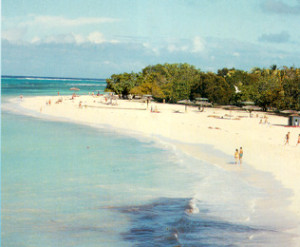CUBA’S MOST BEAUTIFUL BEACHES: “GUARDALAVACA”.
Guardalavaca is a town in the Holguín Province of Cuba. Better known for its white sandy beaches.
It is located on the northern shore of Cuba, bordering Bahia de Naranjo (Orange Bay), on Cabo Lucrecia, and is part of the municipality of Banes. Beaches in Guardalavaca include Guardalavaca Beach, Playa Esmeralda, Don Lino and Bahia de Naranjo.
“Guardalavaca” literally means “guard the cow” in Spanish. There are several accounts as to how this name may have originated; one version maintains that Guardalavaca is a malapropism for its original name Guardalabarca, meaning “guard the ship”. The area was once heavily targeted by sea pirates, and Bahía de Naranjo near what is now the town of Guardalavaca is a secluded shallow bay connected to the open sea by a narrow inlet, which made it a proper safe haven to guard ships against pirates. On the other hand, the name may have originated from pirates going after the cattle grazing in the area. As pirates were spotted, the local farmers would thus shout, “Guardalavaca” – guard the cow.
The Cuban government has attempted on several occasions to change the name of the area as they deem it not to be very appealing; they have so far been unsuccessful.
Agencies/Various/Wiki/InternetPhotos/thecubanhistory.com
The Cuban History, Hollywood.
Arnoldo Varona, Editor.
LAS MÁS BELLAS PLAYAS DE CUBA: “GUARDALAVACA” .
Guardalavaca es un pequeño pueblecito dentro de la provincia de Holguín en Cuba. Mas conocida desde hace muchos anos por su belleza de arenas blancas.
Se encuentra en la costa norte de Cuba, bordeando Bahía de Naranjo (Orange Bay), en Cabo Lucrecia, y es parte del municipio de Banes. Playas en Guardalavaca incluyen Playa Guardalavaca, Playa Esmeralda, Don Lino y Bahía de Naranjo.
“Guardalavaca” literalmente significa “guardia de la vaca” en español. Hay varias cuentas en cuanto a cómo este nombre puede tener su origen; una versión sostiene que Guardalavaca es una malapropism por su nombre original Guardalabarca, que significa “guardia de la nave”. El área fue una vez fuertemente atacado por piratas del mar, y la Bahía de Naranjo, cerca de lo que hoy es la ciudad de Guardalavaca es una bahía poco profunda aislada conectada con el mar abierto por un estrecho, lo que hizo un refugio seguro adecuado para proteger los barcos de los piratas. Por otra parte, el nombre puede tener su origen en los piratas que van tras el ganado que pasta en la zona. Como fueron vistos piratas, los agricultores locales serían por lo tanto gritar, “Guardalavaca” – custodiar la vaca.
El gobierno cubano ha intentado en varias ocasiones cambiar el nombre de la zona que consideren no es muy atractivo; hasta el momento no han tenido éxito.
Agencias / Varios / Wiki / InternetPhotos / thecubanhistory.com
The Cuban History, Hollywood.
Arnoldo Varona, Editor.





